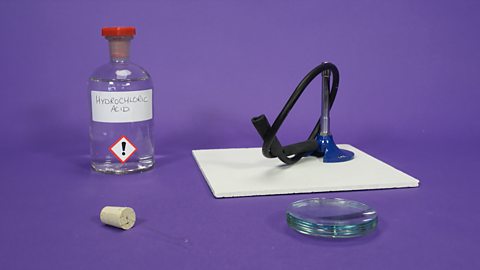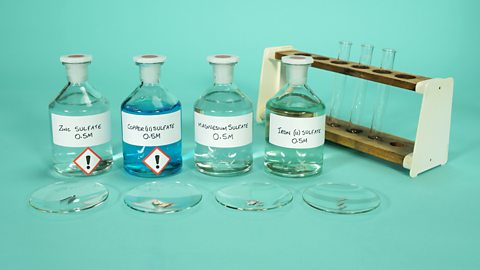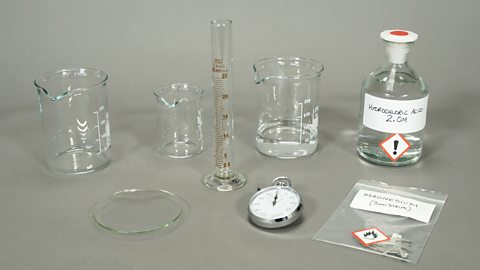What are the key learning points about practical C2?
acidCorrosive substance which has a pH lower than 7. Acidity is caused by a high concentration of hydrogen ions. can react with metals, metal oxides, metal hydroxides and metal carbonates.
A number of characteristic observations can be made for these reactions.
In these experiments you will measure temperatures increase and test hydrogen and carbon dioxide gases produced in acid reactions.
What is the purpose of C2 investigating the reaction of acids?
Acids can react in a number of ways. For example, acids can react with:
metals
metal oxides
metal hydroxides
metal carbonates
You will carry out four different experiments to investigate these reactions of acids.
Experiment 1: What happens when an acid reacts with a metal?
An acid will release hydrogen gas when reacted with a metal:
acid + metal → salt + hydrogen
In this experiment, you will react magnesium with hydrochloric acid to produce magnesium chloride (a saltA compound formed during a neutralisation reaction when some or all of the hydrogen ions in an acid are replaced with metal ions or ammonium ions.) and hydrogen gas:
hydrochloric acid + magnesium → magnesium chloride + hydrogen
The hydrogen gas produced can be trapped and tested with a lit splint.
Investigate the reactions of acids with a metal.
What apparatus and chemicals are used in experiment 1?
Boiling tubes
Boiling tube rack
Measuring cylinder (25 cm3)
Safety glasses
Wooden splint
1 mol/dm3 hydrochloric acid (15 cm3)
2 cm strip of magnesium
What are the steps involved in carrying out experiment 1?
Measure 15 cm3 of hydrochloric acid using the measuring cylinder and add to the boiling tube.
Add the magnesium strip to the boiling tube – ensuring that the magnesium is fully immersed in the acid by swirling and allow the reaction to proceed for 10 seconds.
After 10 seconds, place a second boiling tube upside-down over the top of the first boiling tube to trap the gas produced.
Light a splint. Insert the splint into the upside-down boiling tube.
What observations are recorded when an acid reacts with a metal?
Reaction of magnesium and hydrochloric acid:
gas produced (hydrogen).
heat produced.
solid metal disappears.
colourless solution forms.
Lit splint inserted into trapped gas:
- squeaky pop produced.
Experiment 2 – What happens when an acid reacts with a metal oxide?
An acid will react with metal oxides:
acid + metal oxide → salt + water
In this reaction, you are going to use sulfuric acid and copper(II) oxide:
sulfuric acid + copper(II) oxide → copper(II) sulfate + water
In this reaction no gas is produced.
However, there will be other evidence that a chemical reaction is taking place.
Reactions of acids with metal oxides.
What apparatus and chemicals are used in experiment 2?
Kettle
250 cm3 beaker
100 cm3 beaker
Measuring cylinder
Spatula, watch glass, glass rod
Heatproof mat
Safety goggles
Sulfuric acid 0.5 mol/dm3
Copper(II) oxide (2 g)
pH paper
What are the steps involved in carrying out experiment 2?
Using pH paper determine the pHScale of acidity or alkalinity. A pH (power of hydrogen) value below 7 is acidic, a pH value above 7 is alkaline. Neutral solutions have a pH of 7.of the acid at the start, record this in your results.
Using a measuring cylinder, measure out 25 cm3 of sulfuric acid into the small beaker.
Collect approximately 2 g of copper(II) oxide on a watch glass.
Using hot water from a kettle, fill 1/3 of the larger beaker with hot water.
Warm the sulfuric acid beaker by letting it rest (carefully) in the hot water bath (leave for 2 min).
Carefully remove the small beaker and add copper(II) oxide to the acid slowly, stir with a glass rod.
Keep adding the copper(II) oxide, until there is some left over at the bottom of the beaker. Let the beaker sit for 2 min to allow the black powder to settle.
What observations are recorded when an acid reacts with a metal oxide?
At the start of the reaction the pH of the acid is 1-2
At the end of the reaction the pH of the solution is close to pH 7
Blue solution produced
Heat produced
Most of the black solid disappears
Experiment 3: What happens when an acid reacts with a metal hydroxide?
An acid will react with a metal hydroxide in a similar manner to the reaction with a metal oxide:
acid + metal hydroxide → salt + water
In this experiment we will react hydrochloric acid with sodium hydroxide and measure the temperature increase during the reaction:
hydrochloric acid + sodium hydroxide → sodium chloride + water
No gas is produced.
Also, in this reaction there is no colour change.
However, the temperature will increase and the pHScale of acidity or alkalinity. A pH (power of hydrogen) value below 7 is acidic, a pH value above 7 is alkaline. Neutral solutions have a pH of 7. will change – you could measure this as described in the previous reaction.
Reaction of acids that produce heat
What apparatus and chemicals are used in experiment 3?
Polystyrene cup and lid
250 cm3 beaker
Thermometer
Measuring cylinder (25cm3)
1 mol/dm3 hydrochloric acid (25cm3)
1 mol/dm3 sodium hydroxide (25cm3)
What are the steps involved in carrying out experiment 3?
Place the polystyrene cup into the 250 cm3 beaker to stabilise it.
Carefully measure 25 cm3 of hydrochloric and place it in the polystyrene cup.
Take the initial temperature of the hydrochloric acid and record it in the results table.
Wash out the measuring cylinder and rinse it with a little sodium hydroxide solution.
Then measure 25 cm3 of sodium hydroxide solution into the measuring cylinder.
Add the sodium hydroxide solution to the acid, stir with the thermometer, measure and record the highest temperature reached during the reaction.
| Initial temperature of hydrochloric acid / °C | Highest temperature reached in reaction / °C | Temperature change / °C |
|---|---|---|
What are the results when an acid reacts with a metal hydroxide?
During this reaction the H+ ionAn atom or molecule that has either a positive or negative electrical charge. from the acid and the OH- ions from the alkaliA base which is soluble in water. A base is a substance which neutralises an acid. react together to form water.
As this happens, energy is released which is detected as a temperature increase on the thermometer.
The polystyrene cup is a good insulator which prevents heat from escaping from the reaction.
Experiment 4: What happens when an acid reacts with a metal carbonate?
The final characteristic reaction of an acid is that it will produce carbon dioxide gas when reacted with a metal carbonate.
acid + metal carbonate → salt + water + carbon dioxide
In this experiment you will react calcium carbonate with hydrochloric acid:
hydrochloric acid + calcium carbonate → calcium chloride + water + carbon dioxide
The carbon dioxide gas which is released during the reaction will cause limewater to change from a colourless solution to milky.
Reaction of acids with a metal carbonate
What apparatus and chemicals are used in experiment 4?
Measuring cylinder
Boiling tube, test-tube
Disposable pipette/dropper
Test-tube rack
Hydrochloric acid 0.5 mol/dm3 (15 cm3)
Calcium carbonate (3 g)
Limewater (5 cm3)
What are the steps involved in carrying out experiment 4?
Using a measuring cylinder, measuring 15 cm3 of hydrochloric acid and place into the boiling tube.
Using a clean measuring cylinder, measure 5 cm3 of limewater and place into a test-tube. Place the test-tube and boiling tube side by side in a test-tube rack.
Carefully add the calcium carbonate to the acid – record your observations.
Using the disposable pipette/dropper, collect the gas produced by opening and closing the dropper above the reaction in the boiling tube.
Once the gas has been collected in the disposable pipette/dropper, bubble the gas through the limewater and record your observations.
What are the observations when an acid reacts with a metal carbonate?
Reaction of calcium carbonate and hydrochloric acid:
Gas produced.
White solid disappears.
Colourless solution formed.
Gas bubbled through limewater from pipette
- Limewater turns from colourless to milky/cloudy – this indicates the gas produced was carbon dioxide.
How much do you know about the reactions of acid?
More on Unit 3: Prescribed practicals
Find out more by working through a topic
- count4 of 9

- count5 of 9

- count6 of 9
